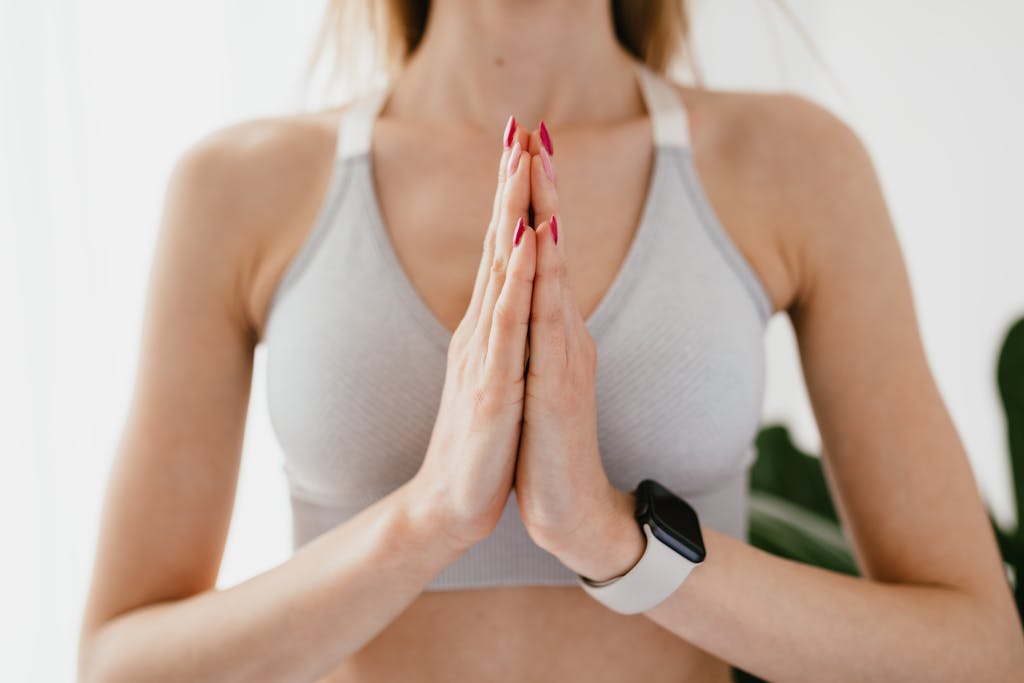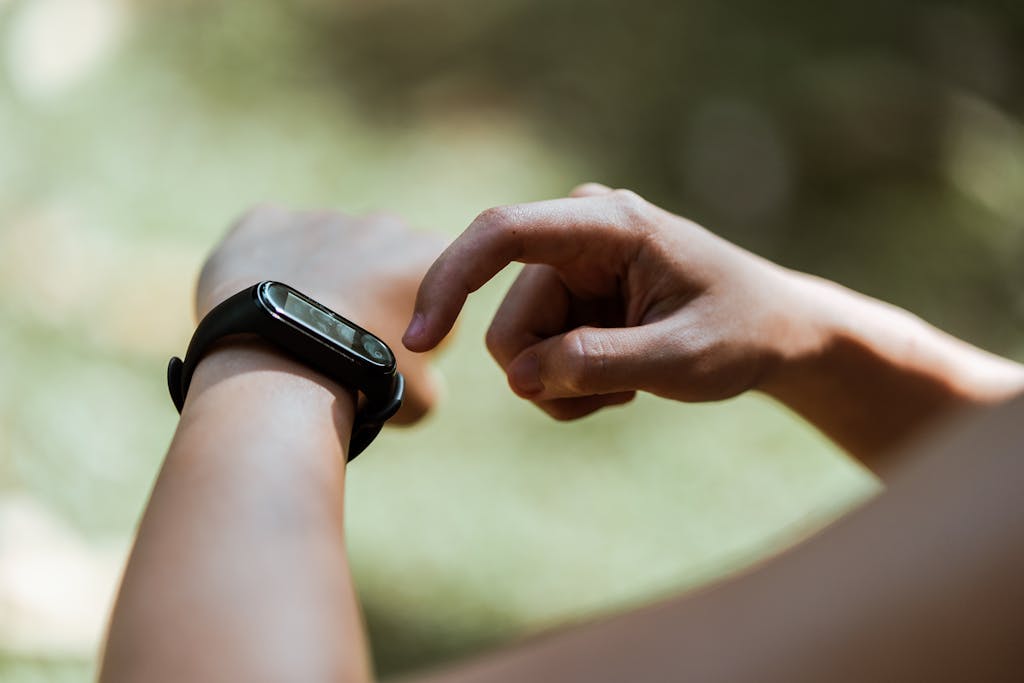Biohacking is revolutionizing the way we approach health and wellness, with fitness trackers leading the charge. Whether you’re looking to monitor your heart rate, improve sleep quality, or track your overall well-being, these wearables offer a wealth of insights. Let’s dive into the best fitness trackers for biohacking and how they can help optimize your body and mind.
What is Biohacking?
Biohacking is the practice of enhancing your body’s natural capabilities through biology, neuroscience, and nutrition. It involves making targeted changes to your diet, exercise routine, and lifestyle to improve your physical and mental health. A biohacker may seek to boost overall well-being, extend lifespan, or even enhance cognitive function.
With the growing interest in personal health and wellness, biohacking wearables have emerged as essential tools to provide real-time feedback on your body’s performance.

How Biohacking Wearables Can Help
Biohacking wearables play a vital role in enhancing both physical and mental well-being. Here are some key ways they assist in your biohacking journey:
- Sleep Tracking: Wearables monitor your sleep stages, such as light, REM, and deep sleep, providing insights into sleep quality. This data helps improve your sleep management by identifying disruptions and optimizing rest patterns.
- Stress Management: By tracking metrics like heart rate variability (HRV) and stress levels, these devices provide real-time feedback, helping you reduce stress and improve mental clarity. This feedback is crucial for managing everyday stress and promoting relaxation.
- Activity Tracking: Wearables record your physical activity, including steps, heart rate, and respiratory rate, which enhances your overall fitness. They provide personalized insights on workout intensity and recovery, helping you optimize your exercise routine.
In addition to these core functions, biohacking wearables can track advanced metrics like blood oxygen levels, body temperature, and mental performance. This gives biohackers detailed insights to make data-driven decisions for improving overall health and longevity.

Best Biohacking Wearables for Fitness Tracking
If you’re looking for the top fitness trackers for biohacking, here are the most advanced wearables:
1. Whoop Strap 4.0
When it comes to maximizing fitness performance, the Whoop Strap 4.0 has become one of my favorite biohacking tools. Unlike other wearables that focus on general activity tracking, Whoop is all about optimizing recovery, fitness performance, and overall readiness. This approach has helped me fine-tune my workouts in ways I hadn’t anticipated.
What It Tracks
- Strain and Recovery: One of the standout features is how Whoop tracks your daily strain and compares it to your recovery. Before using Whoop, I used to push myself every workout, thinking that was the key to progress. What I learned from Whoop’s data is that recovery plays just as significant a role. The strap provides daily insights into how well your body has recovered from previous workouts based on metrics like heart rate variability (HRV) and resting heart rate.
- Heart Rate Monitoring: During intense fitness sessions, I find the continuous heart rate tracking to be incredibly precise. It shows me how hard I’m pushing myself and whether I’m staying in the optimal heart rate zone for my specific goals, whether it’s endurance training or high-intensity workouts.
- Sleep and Recovery Integration: Whoop takes sleep tracking to the next level by showing how my sleep directly impacts my recovery. On days when I get less sleep or lower-quality rest, I now know to adjust my workouts accordingly, which has helped prevent overtraining and burnout. For example, if my sleep score indicates poor recovery, I’ll prioritize light activity or stretching instead of heavy lifting.
- What It Tracks: Blood oxygen saturation, sleep patterns, heart rate, and stress levels.
- Features: Advanced sensors for recovery optimization and performance insights.
- Pros:
- No display for distraction-free tracking.
- Detailed insights on recovery and stress management.
- Excellent for athletes.
- Cons:
- Subscription-based service.
- No inbuilt display or GPS.
Personal Insights on Fitness Performance
Before using the Whoop Strap 4.0, I used to follow a rigid workout schedule without considering my body’s fluctuating readiness. With Whoop, I now base my workouts on my daily recovery score, allowing me to push harder when my body is primed for performance and to rest when I need it most. It has fundamentally changed how I approach fitness, making my progress more sustainable and personalized. The strain coach feature, which provides real-time feedback on whether you’re pushing yourself too hard or not enough, has been especially valuable for fine-tuning my fitness performance.

2. Oura Ring
As a biohacker, I’ve found the Oura Ring to be an essential tool for tracking my health and optimizing various aspects of my well-being. While there are many fitness trackers on the market, the Oura Ring stands out for its ability to provide deep insights into areas that go beyond just steps and calories burned.
What It Tracks
- Sleep Quality: This is where the Oura Ring truly shines. It tracks your sleep patterns, including light, REM, and deep sleep stages, giving you a sleep score that reflects the overall quality of your rest. When I first started using the ring, I was surprised by how much it highlighted my sleep disturbances, especially during REM, which was affecting my energy levels throughout the day.
- Heart Rate: During both activity and rest, the Oura Ring measures heart rate and heart rate variability (HRV), providing insights into how well your body is recovering. Personally, I’ve found the HRV readings incredibly useful in adjusting my workout intensity and stress management techniques.
- Body Temperature: One of my favorite features is the body temperature monitoring. It tracks deviations in your skin temperature, which has helped me catch early signs of stress or illness before they become bigger issues.
- Respiratory Rate: For anyone focused on optimizing their overall well-being, the Oura Ring’s ability to track respiratory rate during sleep adds an additional layer of insight. For me, this has been a game-changer in understanding my sleep apnea symptoms.
- Activity: Although the Oura Ring does track physical activity, I would say it’s more suited for those who prioritize sleep, recovery, and holistic health metrics. It’s not designed to replace a high-end fitnessFeatures: Sleep score, sleep tracking, skin temperature monitoring, and heart rate variability.Pros:
- Lightweight and comfortable.
- Long battery life (up to 7 days).
- Detailed sleep analysis.
- Limited fitness tracking features compared to other wearables.
- Expensive.
Personal Insights: I’ve found the Oura Ring to be one of the best tools for improving my sleep hygiene. The sleep score, in particular, has helped me track changes in sleep patterns and make adjustments, like reducing blue light exposure, for better sleep quality.
3. Fitbit Inspire 3
The Fitbit Inspire 3 is an entry-level fitness tracker designed to help users take their first steps into the world of health monitoring and biohacking. With its sleek design and user-friendly interface, this device makes tracking daily activity and sleep patterns easier than ever.
Equipped with features like heart rate monitoring, sleep tracking, and stress management tools, the Inspire 3 provides valuable insights into your overall health and wellness. Its long battery life ensures you can wear it without interruption, making it a convenient choice for those looking to build healthier habits. Whether you’re a beginner or looking for a straightforward way to keep tabs on your fitness journey, the Fitbit Inspire 3 is a reliable companion for enhancing your well-being.
What It Tracks:
- Steps
- Heart rate
- Sleep stages
- Activity levels
- Calorie burn
Features:
- Sleep Tracking: Monitors sleep stages (light, deep, and REM) to help improve your sleep quality.
- Heart Rate Zones: Tracks heart rate 24/7 and categorizes it into fat burn, cardio, and peak zones for better workout insights.
- Stress Management: Offers tools like guided breathing exercises based on heart rate variability.
- SpO2 (Blood Oxygen Saturation): Helps keep track of your blood oxygen levels for deeper insights into respiratory health.
- Battery Life: Lasts up to 10 days, making it a low-maintenance option.
Pros:
- Affordable: The Fitbit Inspire 3 is an excellent budget-friendly option for biohackers looking to start tracking their health and fitness without breaking the bank.
- User-Friendly: Easy to use with a simple interface, making it perfect for beginners.
- Comprehensive Sleep Tracking: Provides detailed insights into your sleep patterns, helping to improve your overall sleep hygiene.
- Long Battery Life: Lasts up to 10 days on a single charge, which means you don’t have to worry about charging it frequently.
Cons:
- Limited Advanced Features: While it covers the basics very well, it lacks more advanced features like detailed recovery metrics or strain analysis found in high-end fitness trackers like the Whoop Strap or Oura Ring.
- Smaller Display: The smaller screen may not be ideal for those who prefer large, easy-to-read interfaces.
Personal Insights:
I’ve found the Fitbit Inspire 3 to be a great entry point into biohacking. It’s straightforward and tracks all the essential health metrics without the overwhelming data that some more advanced wearables provide. For someone looking to understand their sleep patterns, track daily activity, or improve stress management, this device is an excellent choice. The sleep tracking is particularly insightful, and its guided breathing exercises have been a useful tool for reducing stress throughout the day.
The battery life is another huge plus. I can wear it for over a week without thinking about charging it, which is a refreshing change from other devices that require daily charging. While it might not have the advanced metrics of higher-end trackers, it excels in providing all the fundamental features a beginner biohacker needs.
Overall, the Fitbit Inspire 3 is a reliable and affordable option, especially if you’re just starting your biohacking journey. Its intuitive interface and helpful health metrics make it easy to integrate into your daily routine without being overwhelming.

4. Garmin Venu 3
Garmin Venu 3 is a well-rounded smartwatch that combines fitness tracking with lifestyle optimization. It offers a range of advanced health metrics, making it a powerful tool for biohackers looking to monitor their overall well-being while enhancing their fitness performance. This device goes beyond simple step counting, offering insights into sleep quality, stress management, heart rate variability, and even body battery energy levels.
What It Tracks:
- Heart Rate: Monitors your heart rate continuously throughout the day and during workouts.
- Sleep Stages: Analyzes your sleep patterns by tracking light, deep, and REM sleep stages.
- Body Battery: Provides insights into your energy levels based on heart rate variability and activity data.
- Stress Levels: Tracks your stress throughout the day and offers guided breathing exercises to help you manage it.
- Activity Levels: Records various activities, including running, cycling, swimming, and more.
Features:
- AMOLED Display: A bright and vibrant display allows you to view metrics and notifications easily.
- Long Battery Life: Up to 14 days in smartwatch mode and up to 24 hours in GPS mode, ensuring it lasts for multiple workouts without frequent charging.
- GPS and Maps: Built-in GPS for tracking outdoor activities without needing your phone, complete with route mapping.
- Fitness and Health Insights: Offers personalized insights based on your activity, heart rate, and sleep data.
- Women’s Health Tracking: Includes features for menstrual cycle tracking and pregnancy tracking, adding to its versatility.
Pros:
- Comprehensive Health Metrics: The Venu 3 provides detailed health tracking, making it a valuable tool for biohackers seeking in-depth insights.
- Customizable Workouts: Users can create and download workouts, providing flexibility for varying fitness levels and goals.
- Integrated Music Storage: Allows you to store music or sync playlists from platforms like Spotify and Deezer, making workouts more enjoyable.
- Water-Resistant: Swim-proof design allows for tracking underwater activities, further expanding its functionality.
Cons:
- Price: The Garmin Venu 3 can be more expensive than some other fitness trackers, which may be a consideration for those on a budget.
- Size: While many find the display beneficial, the larger watch face may not be ideal for those who prefer a more compact device.
- Limited Third-Party App Integration: Compared to competitors like the Apple Watch, the Venu 3 has fewer third-party app options.
Personal Insights:
I’ve found the Garmin Venu 3 to be an incredibly versatile tool for both fitness enthusiasts and biohackers. The combination of fitness tracking and lifestyle insights really helps in understanding my overall well-being. I particularly appreciate the Body Battery feature, which gives me a clear indication of my energy levels throughout the day, allowing me to adjust my activities accordingly.
The sleep tracking capabilities are another highlight; not only does it track sleep stages, but it also provides insights into my sleep quality, helping me make adjustments to improve it. The vibrant AMOLED display is easy to read, even outdoors, and the GPS functionality ensures accurate tracking during my runs or outdoor workouts without needing to carry my phone.
In summary, the Garmin Venu 3 is an exceptional choice for those looking to take their biohacking journey seriously, offering a wealth of data and insights to support both fitness goals and overall health.

5. Apple Watch Series 9
The Apple Watch Series 9 is the latest iteration of Apple’s iconic smartwatch, combining cutting-edge technology with a robust set of health and fitness features. Designed for both casual users and fitness enthusiasts, this smartwatch offers an impressive array of metrics and tools for biohackers looking to enhance their well-being.
What It Tracks:
- Heart Rate: Continuously monitors heart rate throughout the day and during workouts, providing valuable insights into cardiovascular health.
- Blood Oxygen Levels: Features a blood oxygen app that measures your blood oxygen saturation, helping you understand your respiratory health.
- Sleep Tracking: Tracks sleep duration and quality, offering insights into your sleep patterns and overall restfulness.
- Activity Tracking: Monitors daily activity levels, including steps taken, calories burned, and minutes of exercise.
- ECG: An ECG app allows you to take an electrocardiogram to check for irregular heart rhythms.
Features:
- Always-On Retina Display: The bright and vibrant display ensures you can easily view notifications, health metrics, and apps at a glance.
- Fitness and Health Apps: Integrates with the Apple Health app and supports a variety of third-party health and fitness applications for a customizable experience.
- WatchOS 10: The latest operating system offers enhanced features, including smarter notifications and widgets for easy access to information.
- Durability: Built with a crack-resistant front crystal, IP6X dust resistance, and WR50 water resistance, making it suitable for various activities.
- Family Setup: Allows family members without an iPhone to use an Apple Watch, making it great for families who want to stay connected.
Pros:
- Ecosystem Integration: Seamlessly integrates with other Apple devices and services, providing a unified user experience.
- Health Features: Comprehensive health tracking, including advanced metrics like ECG and blood oxygen monitoring, supports a proactive approach to well-being.
- Customization: Offers a wide range of bands and customizable watch faces, allowing users to express their personal style.
- User-Friendly Interface: The intuitive interface makes navigation easy, even for those new to smartwatches.
Cons:
- Price: The Apple Watch Series 9 is on the pricier side compared to other fitness trackers, which may deter budget-conscious buyers.
- Battery Life: While it lasts about 18 hours, some users may find this insufficient for extended use without recharging.
- Requires iPhone: To take full advantage of the Apple Watch, an iPhone is necessary, which limits its appeal to non-Apple users.
Personal Insights:
I’ve had the opportunity to use the Apple Watch Series 9, and it has truly transformed how I approach my health and fitness goals. The ability to monitor my blood oxygen levels is particularly valuable; it gives me peace of mind, especially during workouts. The sleep tracking feature is another highlight, providing detailed insights into my sleep quality, which I find essential for optimizing recovery.
The seamless integration with the Apple Health app allows me to view all my health data in one place, making it easy to track my progress over time. I also appreciate the activity reminders, which encourage me to stay active throughout the day.
In summary, the Apple Watch Series 9 is more than just a smartwatch; it’s a comprehensive health and fitness tool that empowers you to take control of your well-being. Whether you’re tracking workouts, monitoring sleep, or managing stress, this device provides the insights and functionality needed to enhance your biohacking journey.

6. Garmin Forerunner 265
The Garmin Forerunner 265 is a sophisticated fitness tracker designed specifically for runners and outdoor enthusiasts. Combining advanced technology with practical features, this watch offers in-depth tracking and analysis to help you optimize your performance and overall health.
What It Tracks:
- Heart Rate: Continuous heart rate monitoring provides insights into your cardiovascular performance and training intensity.
- GPS Tracking: High-sensitivity GPS tracks your routes and distance accurately, making it ideal for outdoor activities like running and cycling.
- Sleep Tracking: Monitors your sleep patterns, offering insights into sleep quality and duration, helping you understand your recovery.
- VO2 Max: Estimates your maximum oxygen uptake during exercise, helping you gauge your fitness level.
- Activity Tracking: Records daily steps, calories burned, and active minutes, encouraging you to meet your fitness goals.
Features:
- Color Touchscreen Display: The vibrant color display is easy to read in various lighting conditions, providing clear visibility of your metrics.
- Training Status and Load: Provides feedback on your training load and status, helping you avoid overtraining and optimize recovery.
- Smart Notifications: Receive texts, calls, and app notifications directly on your wrist, ensuring you stay connected while on the go.
- Customizable Workouts: Create and download training plans tailored to your fitness level and goals, offering a personalized experience.
- Battery Life: Up to 13 hours in GPS mode, ensuring it lasts through long runs and activities without needing a recharge.
Pros:
- Accurate Tracking: The GPS and heart rate monitoring features are highly accurate, making it a reliable choice for serious athletes.
- Performance Insights: Provides advanced metrics like VO2 max and training load, which are valuable for optimizing performance.
- User-Friendly Interface: The intuitive interface and touchscreen make navigation easy, even while in motion.
- Durable Design: Built to withstand the rigors of outdoor activities, it is water-rated and shock-resistant.
Cons:
- Price: While feature-rich, it is more expensive compared to basic fitness trackers, which might be a consideration for casual users.
- Limited Smart Features: While it offers notifications, it lacks some of the more advanced smartwatch functionalities found in competitors.
- Battery Life in Smart Mode: The battery life decreases significantly when using advanced features, requiring more frequent charging.
Personal Insights:
As an avid runner, the Garmin Forerunner 265 has become an essential part of my training routine. The GPS trackingis incredibly reliable, allowing me to explore new routes with confidence, knowing I’ll have accurate distance and pace metrics. The VO2 max feature is particularly insightful; it helps me gauge my fitness level and push my limits as I train for upcoming races.
The training status and load features are also beneficial, offering feedback on whether I’m in the optimal training zone or if I need to dial it back. This real-time feedback has helped me avoid burnout and injuries, ensuring I can train effectively.
In conclusion, the Garmin Forerunner 265 is a robust fitness tracker that offers invaluable insights for runners and athletes. Its advanced tracking capabilities, combined with practical features, make it an excellent choice for anyone looking to elevate their fitness journey. Whether you’re training for a marathon or simply aiming to stay active, this device is a powerful ally in achieving your goals.

7. Fitbit Charge 6
The Fitbit Charge 6 is an advanced fitness tracker designed to help you take control of your health and fitness journey. With its sleek design and powerful features, this device is perfect for those looking to monitor their physical activity, sleep, and overall well-being.
What It Tracks:
- Heart Rate: Continuous heart rate monitoring throughout the day and during workouts to provide insights into your cardiovascular health.
- Sleep Tracking: Analyzes sleep patterns and stages (light, deep, and REM sleep) to help improve sleep quality.
- Activity Tracking: Tracks steps taken, distance traveled, calories burned, and active minutes to motivate you to stay active.
- Blood Oxygen Levels: Measures your blood oxygen saturation (SpO2), which can be useful for assessing respiratory health.
- Stress Management: Monitors heart rate variability and offers mindfulness features to help you manage stress levels effectively.
Features:
- Color Touchscreen Display: The vibrant color display makes it easy to navigate through menus and view your stats at a glance.
- Built-in GPS: Track your outdoor activities without needing to carry your phone, providing accurate distance and pace data.
- Workout Modes: Over 20 exercise modes to choose from, allowing you to track specific workouts, whether it’s running, cycling, or yoga.
- Smart Notifications: Receive texts, calls, and app notifications directly on your wrist to stay connected while on the move.
- Long Battery Life: Up to 7 days of battery life, ensuring you can wear it continuously without frequent recharging.
Pros:
- Comprehensive Health Tracking: Offers a wide range of health metrics, making it a great all-in-one device for fitness enthusiasts.
- User-Friendly Interface: The intuitive touchscreen makes navigating through features and accessing your data simple and straightforward.
- Stylish Design: The sleek and modern design makes it suitable for both workouts and everyday wear.
- Active Zone Minutes: Provides real-time feedback during workouts, helping you understand how hard you’re working and encouraging you to meet your fitness goals.
Cons:
- Limited Advanced Features: Compared to some smartwatches, it may lack advanced apps and functionalities.
- Syncing Issues: Some users have reported occasional syncing issues with the Fitbit app, which can be frustrating.
- Price: While it offers great features, it is priced higher than basic fitness trackers, which may not be suitable for all budgets.
Personal Insights:
As someone who prioritizes both fitness and well-being, the Fitbit Charge 6 has been an invaluable addition to my daily routine. The sleep tracking feature has provided me with detailed insights into my sleep patterns, allowing me to make adjustments for better sleep quality. I’ve noticed that on nights when I prioritize my sleep hygiene, my sleep score improves significantly.
The built-in GPS is another standout feature for me. Whether I’m out for a run or cycling through my neighborhood, I appreciate being able to track my routes and distances accurately without carrying my phone. It gives me the freedom to focus on my performance instead of worrying about my phone battery.
The Active Zone Minutes feature has also motivated me to push myself during workouts. Knowing that I’m working in different heart rate zones has helped me optimize my training sessions. Plus, the stylish design means I can wear it throughout the day without it feeling out of place.
Overall, the Fitbit Charge 6 is a versatile fitness tracker that offers a great balance of functionality and style. It’s perfect for anyone looking to enhance their health and fitness journey, providing valuable insights and encouragement to stay active and healthy.
These top fitness trackers not only provide key health metrics but also offer the personalized insights necessary for biohackers to optimize their health and fitness journey. When choosing the right one, it’s important to consider what metrics you need, whether you’re focused on sleep tracking, stress management, or activity monitoring. Each device has its strengths, so pick the one that best aligns with your biohacking goals.

The Future of Biohacking Wearables
The future of biohacking wearables looks promising with advancements in:
- AI-powered wearables: More personalized insights and recommendations.
- Smart rings and advanced sensors: Increasing accuracy for health tracking.
- Tailored recommendations: Devices will offer more specific lifestyle and fitness advice.
Conclusion
Biohacking wearables offer the tools to enhance both physical and mental health by providing real-time feedback. The Oura Ring, Whoop Strap 4.0, and Fitbit Inspire 3 stand out as top picks. When choosing a fitness tracker for biohacking, consider the metrics you need, the features you prefer, and your budget to find the best fit for your wellness journey.






